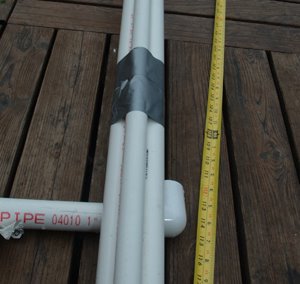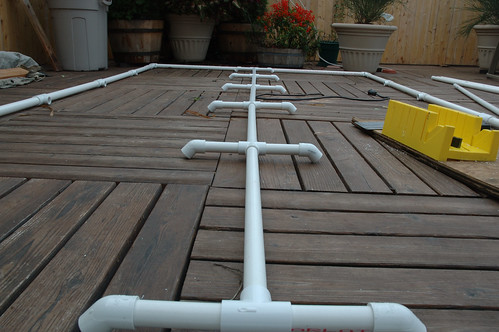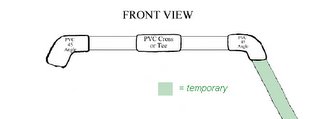Ridge Beam
Assembling the ridge beam (and rafters) was one of the most satisfying parts of this project.
The hard part:Assembling the parts is rather straight forward. However, when it comes time to glue the parts together it is imperative that all the T's and the X's are on the same plane. In other words, the fully assembled ridge beam, together with the fittings, should rest flat when placed on a flat surface. This is key, because without the fitting laying flat on the same plane, one or more ribs, when attached, will be flying off too wide or tucked in too narrowly to be uniform. Don't worry. I provide tips down below to help gurantee your success.
Ridge Beam:You begin with the 3/4" 10 foot pole which is now cut into 5 pieces. Add a 3/4" T on the end of part number 1 with the pole being the center of the T. Then connect part 1 to part 2 with a 3/4" cross fitting keeping the pole straight. Connect all the other parts with
cross fittings. For the last piece, cap it with a T on the end like you did for part one. The result is something that is friction fit together and looks like this:
I--+--+--+--+--I
Now let's glue the part together.
PVC bonding glue looks and smells like rubber cement you use in crafts. DO NOT BE FOOLED. When used to assemble PVC pipe and fitting it very hard after 5 seconds and rock hard and virtually unmoveable in 10 seconds. Trying to undo a glued fitting will prabably crack the fitting. So when it is time to glue, be sure and be quick.
Glue the T fitting to part one by running the PVC glue brush around the inside of the fitting and the outside of the pole. Push the two together. This one is easy. Use it to practice and get a feel for gluing PVC. Use a wood block or a 10 inch piece of PVC pipe as a hammer to really force them togther. Don't slam too hard and don't hammer aginst your wooden deck unless you want a lot of round gouges in your deck surface. ( Also, don't use a real hammer, it will crack the PVC. )
So here is how you keep all the fitting aligned while gluing
1. You now have ththe T and pipe part 1 glued together...
2. And you want to add a cross like the image below BUT the T and and cross have to be perefctly flat on the same plane.

So...
3. The strategy is called "make a square" strategy. You will connect additional pipes and crosses to the parts you will glue so that you can force them to be squarly aligned. (See image below.) All of the parts you add will just be friction fit. When you apply glue to the cross and the pipe you will have the leverage of the temporary pipe and fitings to force your glued parts into square. Your square could twist so placing it on a flat surface before the glue sets will help as well.

Repeat for Ridge Beam section 2 through 5 ending with a T fitting on the end of 5.
When you are done you will have this only it will be about 10' 6" long
Tags: greenhouse, pvc, roof deck



 Reassemble the base with T-fittings
Reassemble the base with T-fittings







